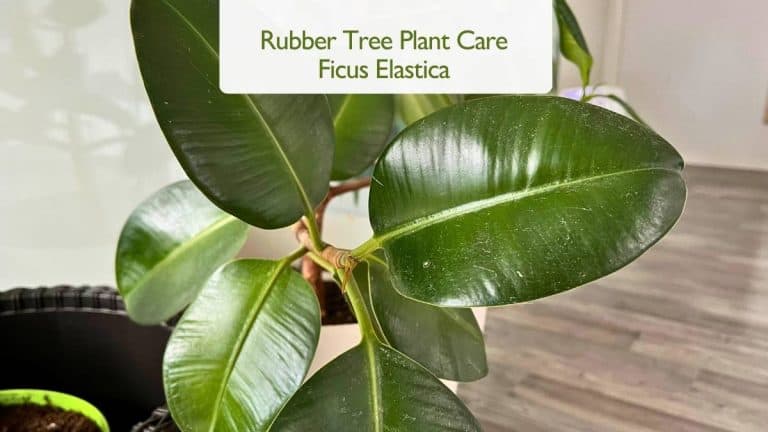Rubber Tree Plant Care: All You Need To Know for Thriving Ficus Elastica
If you want a bold statement plant that’s still beginner-friendly, Rubber tree plant care (Ficus elastica) is a great place to start. With large, glossy leaves and fast vertical growth, Rubber trees can turn a bright corner into a lush, indoor focal point. In this guide, you’ll learn how to dial in light, watering, soil, humidity, feeding, pruning and shaping, repotting, propagation, and quick fixes for common problems – so your Rubber tree stays healthy, upright, and beautifully polished.
Light Requirements for Rubber Tree Plant Care

Bright, indirect light is ideal. A spot near an east window or a few feet back from a south/west window works perfectly. Variegated cultivars like ‘Tineke’ and ‘Ruby’ need more brightness to keep their cream/pink pattern; ‘Burgundy’ tolerates slightly lower light but still prefers it bright.
- Direct, harsh sun can scorch leaves (especially pale variegation).
- Too little light causes slow, leggy growth and leaf drop.
- Rotate the pot every 1–2 weeks for even growth and straight stems.
Consistent brightness is one of the biggest wins in Rubber tree plant care – it stabilizes growth and keeps foliage glossy.
Watering: Evenly Moist, Never Soggy
Let the top 1–2 inches (2–5 cm) of the mix dry before watering thoroughly. Drain completely; never leave the pot sitting in runoff.
Signs to watch:
- Overwatered: yellowing lower leaves, consistently wet mix, musty smell, soft stems.
- Underwatered: drooping, curling edges, dry mix pulling from the pot.
Use the finger test + pot weight. In brighter, warmer rooms you’ll water more often; in lower light and winter, less often. Steady moisture without waterlogging is key to Rubber tree plant care. Read more about Houseplants Watering Tips.
Best Soil Mix – Rubber tree plant care
Choose a well-draining, airy mix that holds moisture lightly but doesn’t stay wet:
- 50–60% high-quality indoor potting mix (peat/coco based)
- 20–30% perlite or pumice (drainage & oxygen)
- 10–20% fine orchid bark (structure)
- A pinch of horticultural charcoal (optional)
Good structure keeps roots oxygenated and reduces rot risk as plants get taller and thirstier.
Humidity & Temperature
Rubber trees love moderate humidity (45–60%) and stable warmth.
- Temperature: 65–80°F (18–27°C) is ideal.
- Avoid cold drafts, heater blasts, or AC streams – sudden swings = leaf drop.
- Wipe leaves monthly with a damp microfiber cloth to remove dust and boost shine (better photosynthesis and fewer pests).
Fertilizing for Steady Growth – Rubber tree plant care
Feed lightly during spring–summer when growth is active:
- Balanced liquid fertilizer at ½ strength every 4–6 weeks, or
- A gentle slow-release fertilizer per label.
Pause feeding in winter. Over-fertilizing can burn margins (especially on variegated leaves), so think little and regular, not heavy.
Pruning, Shaping & Support – Rubber tree plant care
- Topping to branch: Cut the main stem just above a node to encourage side shoots and a fuller silhouette.
- Notching: Make a shallow cut above a node to stimulate branching without losing height.
- Staking: Tall plants appreciate a discreet stake to prevent leaning; rotate for symmetry.
- Sap caution: Rubber trees bleed latex when cut. Wear gloves, protect surfaces, and blot sap with a paper towel. Avoid getting sap on skin/eyes.
Strategic shaping is a hallmark of successful Rubber tree plant care, especially in small spaces where height escalates fast.
Potting & Repotting
Repot every 1–2 years or when roots circle heavily and watering frequency spikes. Size up only 1–2 inches (2–5 cm) wider to avoid soggy mix around fresh roots. Use a pot with ample drainage holes and refresh into your airy mix. After repotting, keep light bright and watering moderate for 1–2 weeks while roots settle.
Propagation (Cuttings & Air Layering)
Stem cuttings (easiest):
- Take a 6–8″ cutting with 2–3 nodes. Wear gloves (latex).
- Remove the lowest leaf; optional: dip in rooting hormone.
- Root in water (change weekly) or in moist mix (high humidity, bright indirect light).
- Pot up once roots are ~2–3″ (5–7 cm).
Air layering (very reliable):
- Make a shallow cut on a mature stem just below a node; insert a toothpick to keep it slightly open.
- Wrap with moist sphagnum + plastic film; secure.
- Once you see strong roots through the moss (4–8 weeks), cut below the layer and pot the new plant.
Air layering is fantastic for tall, leggy Rubber trees you want to shorten while keeping a thriving top.
Common Problems & Quick Fixes – Rubber tree plant care
- Dropping leaves after moving: Normal acclimation; stabilize light and watering, avoid drafts.
- Brown edges/tips: Low humidity, underwatering, or salt buildup—raise humidity, adjust watering, flush soil occasionally.
- Yellowing lower leaves: Overwatering or natural aging; check drainage and cadence.
- Variegation fading: Insufficient light—move brighter (indirect).
- Sticky residue: Could be natural latex droplets or pest honeydew—inspect closely (see below).
Pests & Prevention
Scale, mealybugs, and spider mites are the usual suspects. Inspect leaf undersides, petioles, and midribs every 1–2 weeks.
- Wipe leaves regularly; prune heavily infested bits.
- Treat early with insecticidal soap or neem oil; repeat weekly for 2–3 rounds.
- Quarantine new plants.
Helpful articles: How to Get Rid of Mealybugs and How to Get Rid of Spider Mites on Houseplants.
Pet Safety
Ficus elastica contains calcium oxalates and latex sap that can irritate skin and is toxic if chewed by pets. Keep out of reach of cats, dogs, and curious kiddos.
Clean, Glossy, Pest-Free Leaves (Video Recipe)
Shiny, dust-free foliage isn’t just for looks – it’s core to Rubber tree plant care because clean leaves photosynthesize better and are less inviting to pests. In the video below, I show exactly how I clean my Ficus elastica leaves with a gentle, homemade mix and the right wiping technique. Watch the video below:
Click here to watch the video on YouTube
Seasonal Routine (At-a-Glance) – Rubber tree plant care
- Spring: Resume light feeding; consider topping/notching; repot if rootbound.
- Summer: Watch watering cadence; provide airflow; monitor for pests.
- Autumn: Taper fertilizer; reduce watering frequency as growth slows.
- Winter: Maximize light; avoid drafts; water less often but don’t let it bone-dry for long.
A simple calendar keeps Rubber tree plant care consistent and stress-free all year.
Final Thoughts
Nail the basics – bright, indirect light; evenly moist but well-drained soil; stable warmth and moderate humidity – and your Rubber tree will reward you with upright, glossy growth and serious interior impact. Add gentle shaping, occasional leaf-wiping, and smart repotting, and Ficus elastica becomes one of the most satisfying houseplants you’ll ever grow.
Explore More Music for Your Plants & Stay Connected!
Check out my Playlist: Music for Plants and find the perfect tunes to help your plants and yourself thrive.
Don’t forget to visit my YouTube Channel Plant House & Garden and subscribe — your support means the world to me!
Connect with me on social media for more plant care tips and music updates: Instagram | Facebook | X | Pinterest | Reddit | TikTok
Love plants? Love music? Don’t miss out on new updates — hit subscribe and follow now to keep your plants happy and your space vibrant!







